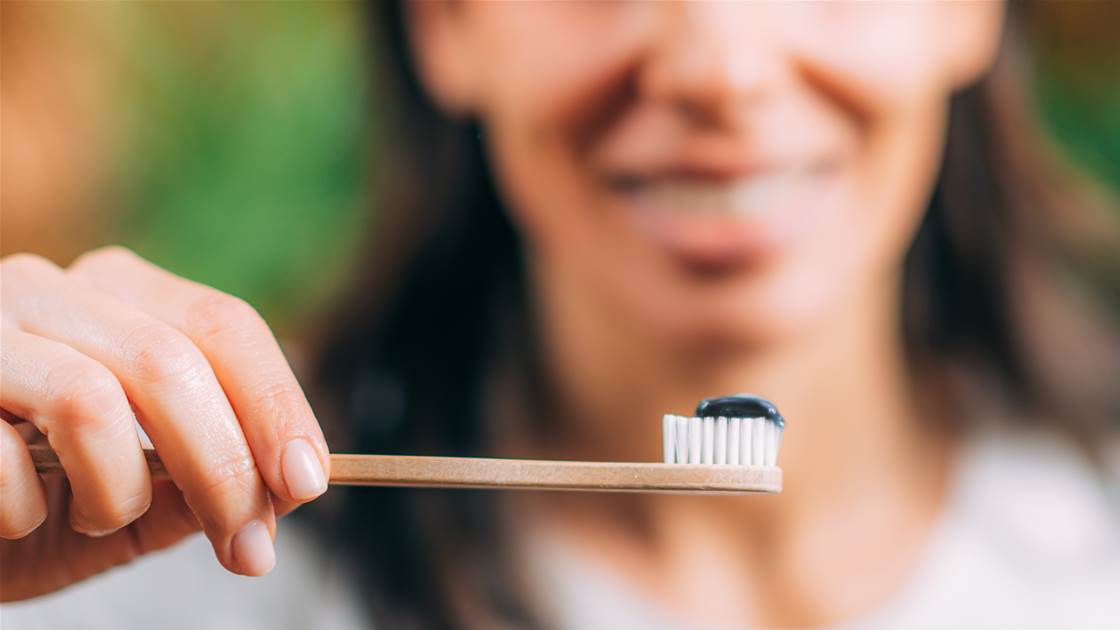If you’ve scrolled through TikTok lately, you’ve probably seen people swearing by sleek black tubes promising whiter, brighter teeth thanks to activated charcoal. But does charcoal toothpaste actually work?
This isn’t the first time the buzzy ingredient has popped up everywhere. Over the years influencers have raved about face masks, supplements and more products with charcoal front and centre. Sometimes the hype seems deserved, but what about charcoal toothpaste?
Advocates say charcoal toothpaste lifts stains and “detoxes” your mouth, yet many dentists aren’t so quick to smile. Evidence for charcoal toothpaste’s whitening or oral-health benefits is limited and raises concerns about abrasivity and the lack of fluoride in some formulas.
“Charcoal toothpaste has become a huge fad online—especially on TikTok—with videos showing dramatic whitening results,” says cosmetic dentist Tyler Hales. “While it might look effective, the truth is more complicated.”
So is this trendy black paste worth a spot on your bathroom shelf or is a standard fluoride toothpaste the smarter choice? Here’s what dentists say about whether charcoal toothpaste really works, plus other whitening options to consider.
Does toothpaste with charcoal work?
Dentists generally agree charcoal toothpaste can make teeth look a touch whiter straight after brushing. Activated charcoal binds surface stains, so light polishing may lift minor discolouration from coffee or red wine and leave teeth feeling smoother. As dentist Johannes Jacobs notes, patients often report that their teeth “feel cleaner” or look a shade brighter after a few uses.
Dentist Nicole Khalife agrees it can “give the illusion of a brighter smile,” but both stress the effect is superficial and short lived. Whether it “works” depends on expectations—think cosmetic tidy-up, not a true whitening treatment or decay protection.
Benefits of toothpaste with charcoal
The upside is limited. The mild abrasiveness can buff away light, surface-level stains which may make teeth appear slightly brighter right after brushing. That quick visual change helps explain the hype on social media.
The longer-term picture is different though: charcoal pastes do not bleach enamel, do not treat deeper stains and many formulations lack fluoride, which is essential for cavity protection.
Potential downsides of toothpaste with charcoal
That same grit that buffs away surface stains can work against you over time. Abrasive particles may wear down enamel, which can lead to sensitivity and a dull, chalky look.
Dentists report that people who brush forcefully or use very gritty pastes sometimes develop increased sensitivity or teeth that look flatter and less glossy. Once enamel is worn, it does not regenerate.
A 2021 study found that 12 weeks of brushing with a charcoal toothpaste delivered no clinically meaningful whitening yet increased surface roughness from enamel abrasion. Rougher enamel is harder to keep clean and may raise the risk of gum recession and tooth decay over time.
There are other concerns. Fine charcoal particles may lodge in gums, tiny cracks or along the edges of crowns and veneers, where they are difficult to remove. Many charcoal formulas also skip fluoride, which helps strengthen enamel and protect against tooth decay. If you are set on trying a charcoal paste, use a soft brush, a light hand and stick to occasional use, then return to a fluoride toothpaste for daily protection.
Other teeth whitening options
The idea of safe, effective at-home whitening is appealing, which is why chemists and supermarkets stock so many whitening pastes and strips. But dentists caution that while some products can lift surface stains, they won’t change the underlying tooth colour the way professional treatments can. If lasting brightness is the goal, in-chair whitening or a dentist-supervised take-home programme is the more predictable route.
If you want a natural, surface-stain helper, plain baking soda (sodium bicarbonate) is a mild abrasive that can help polish away everyday discolouration without the harsh grit of some trend ingredients. Use it sparingly and never scrub hard.
The bottom line
If you’ve already tried a charcoal paste or plan to experiment, go gently. Choose a mild formula that includes fluoride, use it no more than once or twice a week alongside a regular fluoride toothpaste and book routine dental checks so any enamel wear or gum irritation is picked up early.
Trendy pastes can look great on social media, but a healthy, luminous smile comes from consistent oral hygiene, professional cleans, safe whitening when appropriate and enamel-friendly habits. Charcoal can sit in the mix only with clear expectations and careful use.










